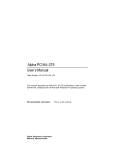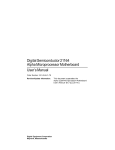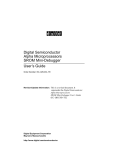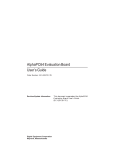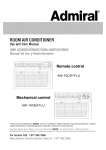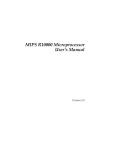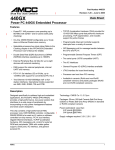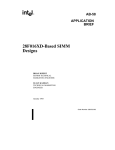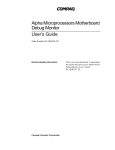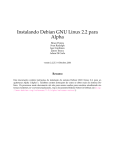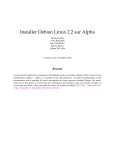Download Digital Equipment Corporation AlphaPC64 User`s manual
Transcript
AlphaPC64 Motherboard User’s Manual Order Number: EC–QLJKB–TE Revision/Update Information: Digital Equipment Corporation Maynard, Massachusetts This document supersedes the AlphaPC64 Motherboard User’s Manual (EC–QLJKA–TE). July 1995 Possession, use, or copying of the software described in this publication is authorized only pursuant to a valid written license from Digital or an authorized sublicensor. While Digital believes the information included in this publication is correct as of the date of publication, it is subject to change without notice. Digital Equipment Corporation makes no representations that the use of its products in the manner described in this publication will not infringe on existing or future patent rights, nor do the descriptions contained in this publication imply the granting of licenses to make, use, or sell equipment or software in accordance with the description. © Digital Equipment Corporation 1995. All rights reserved. Printed in U.S.A. AlphaGeneration, DEC, DECchip, DECladebug, Digital, OpenVMS, VAX, VAX DOCUMENT, VMS, the AlphaGeneration design mark, and the DIGITAL logo are trademarks of Digital Equipment Corporation. Digital Semiconductor is a Digital Equipment Corporation business. Digital UNIX Version 3.2 for Alpha is a UNIX 93 branded product. Centronics is a trademark of Genicom Corporation. CompuServe is a registered trademark of CompuServe, Inc. GRAFOIL is a registered trademark of Union Carbide Corporation. IEEE is a registered trademark of The Institute of Electrical and Electronics Engineers, Inc. Intel and UPI are trademarks of Intel Corporation. MACH is a trademark of Advanced Micro Devices, Inc. Micron is a registered trademark of Micron Corporation. Motorola is a registered trademark of Motorola, Inc. National is a registered trademark of National Semiconductor Corporation. Microsoft is a registered trademark, NT, and Windows NT are trademarks of Microsoft Corporation. OSF and OSF/1 are registered trademarks of Open Software Foundation, Inc. PHOENIX is a registered trademark of Phoenix Technologies, Ltd. PS/2 is a registered trademark of International Business Machines Corporation. SPEC is a trademark of Standard Performance Evaluation Corporation. TriQuint is a registered trademark of TriQuint Semiconductor, Inc. UNIX is a registered trademark in the United States and other countries, licensed exclusively through X/Open Company Ltd. All other trademarks and registered trademarks are the property of their respective owners. This document was prepared using VAX DOCUMENT Version 2.1. Contents About This Manual . . . . . . . . . . . . . . . . . . . . . . . . . . . . . . . . . . . . . . . . . . . vii 1 AlphaPC64 Introduction 1.1 The AlphaPC64 Motherboard . . . . . . . . . 1.2 System Components and Features . . . . . 1.2.1 Memory Subsystem . . . . . . . . . . . . . 1.2.2 DECchip 21072 Support Chipset . . . 1.2.3 PAL Control Set . . . . . . . . . . . . . . . . 1.2.4 Level 2 Cache Subsystem Overview . 1.2.5 Clock Subsystem Overview . . . . . . . 1.2.6 PCI Interface Overview . . . . . . . . . . 1.2.7 ISA Interface Overview . . . . . . . . . . 1.2.8 Software Support . . . . . . . . . . . . . . . 1.2.9 Component Layout . . . . . . . . . . . . . . 1.2.10 System Summary . . . . . . . . . . . . . . . . . . . . . . . . . . . . . . . . . . . . . . . . . . . . . . . . . . . . . . . . . . . . . . . . . . . . . . . . . . . . . . . . . . . . . . . . . . . . . . . . . . . . . . . . . . . . . . . . . . . . . . . . . . . . . . . . . . . . . . . . . . . . . . . . . . . . . . . . . . . . . . . . . . . . . . . . . . . . . . . . . . . . . . . . . . . . . . . . . . . . . . . . . . . . . . . . . . . . . . . . . . . . . . . . . . . . . . . . . . . . . . . . . . . 1–1 1–1 1–1 1–4 1–4 1–4 1–5 1–5 1–5 1–6 1–6 1–6 . . . . . . . . . . . . . . . . . . . . . . . . . . . . . . . . . . . . . . . . . . . . . . . . . . . . . . . . . . . . . . . . . . . . . . . . . . . . 2–1 2–1 2–6 2–7 Hardware Requirements . . . . . . . . . . . . . . . . . . . . . . . . . Software Requirements . . . . . . . . . . . . . . . . . . . . . . . . . . Hardware Configuration . . . . . . . . . . . . . . . . . . . . . . . . . Software Configuration . . . . . . . . . . . . . . . . . . . . . . . . . . Starting Windows NT ARC Firmware . . . . . . . . . . . . Going to the Debug Monitor from Windows NT ARC Firmware . . . . . . . . . . . . . . . . . . . . . . . . . . . . . . . . . . . . . . . . . . . . . . . . . . . . . . . . . . . . . . . . 3–1 3–2 3–2 3–9 3–9 ...... 3–9 2 System Jumpers and Connectors 2.1 2.1.1 2.1.2 2.2 Configuration Jumpers . . . . . . . . . . . . Software Configuration Jumpers . Hardware Configuration Jumpers AlphaPC64 Board Connectors . . . . . . . . . . . . . . 3 Starting and Using the AlphaPC64 3.1 3.2 3.3 3.4 3.4.1 3.4.2 iii 3.4.3 Returning to Windows NT ARC Firmware from the Debug Monitor . . . . . . . . . . . . . . . . . . . . . . . . . . . . . . . . . . . . . . . . . 3–10 4 Functional Elements 4.1 4.1.1 4.1.2 4.2 4.3 4.4 4.4.1 4.4.2 4.4.3 PCI Interrupts and Arbitration . System Interrupts . . . . . . . . PCI/ISA Arbitration . . . . . . . ISA Devices . . . . . . . . . . . . . . . . dc Power Distribution . . . . . . . . Flash ROM (System ROM) . . . . . Special Flash ROM Headers Flash ROM Structure . . . . . . Flash ROM Access . . . . . . . . . . . . . . . . . . . . . . . . . . . . . . . . . . . . . . . . . . . . . . . . . . . . . . . . . . . . . . . . . . . . . . . . . . . . . . . . . . . . . . . . . . . . . . . . . . . . . . . . . . . . . . . . . . . . . . . . . . . . . . . . . . . . . . . . . . . . . . . . . . . . . . . . . . . . . . . . . . . . . . . . . . . . . . . . . . . . . . . . . . . . . . . . . . . . . . . . . . . . . . . . . . . . . . . . . . . . . . . . . . . . . . . . . 4–1 4–1 4–5 4–6 4–7 4–9 4–9 4–12 4–14 Power Requirements . . . . . . . . . . . . . . . . . . . . . . . . . . . . . . . . . . Environmental Characteristics . . . . . . . . . . . . . . . . . . . . . . . . . . . Physical Board Parameters . . . . . . . . . . . . . . . . . . . . . . . . . . . . . 5–1 5–2 5–2 5 Board Requirements and Parameters 5.1 5.2 5.3 A Supporting Vendor Products A.1 A.2 Products Included . . . . . . . . . . . . . . . . . . . . . . . . . . . . . . . . . . . . Products Not Included . . . . . . . . . . . . . . . . . . . . . . . . . . . . . . . . . A–1 A–2 B Technical Support and Ordering Information B.1 B.2 B.3 B.4 Technical Support . . . . . . . . . . . . . . . . . . Ordering Digital Semiconductor Products Ordering Associated Literature . . . . . . . . Ordering Third-Party Documentation . . . C Warranty Registration Information iv . . . . . . . . . . . . . . . . . . . . . . . . . . . . . . . . . . . . . . . . . . . . . . . . . . . . . . . . . . . . . . . . . . . . . . . . B–1 B–1 B–2 B–4 Index Figures 1–1 1–2 1–3 2–1 2–2 2–3 3–1 3–2 4–1 4–2 4–3 4–4 4–5 5–1 AlphaPC64 Functional Block Diagram . . . . . . . . . . . . . Maximum and Minimum SIMM Bank Layouts . . . . . . AlphaPC64 Component Layout and Board Dimensions AlphaPC64 Board Jumpers . . . . . . . . . . . . . . . . . . . . . J3 Jumpers/Connectors . . . . . . . . . . . . . . . . . . . . . . . . AlphaPC64 Board Connectors . . . . . . . . . . . . . . . . . . . Fan/Heat Sink Assembly . . . . . . . . . . . . . . . . . . . . . . . AlphaPC64 Power Connectors . . . . . . . . . . . . . . . . . . . Interrupt Control and PCI Arbitration . . . . . . . . . . . . . Interrupt and Interrupt Mask Registers . . . . . . . . . . . ISA Devices . . . . . . . . . . . . . . . . . . . . . . . . . . . . . . . . . dc Power Distribution . . . . . . . . . . . . . . . . . . . . . . . . . Special Header Content . . . . . . . . . . . . . . . . . . . . . . . . Board Component Layout . . . . . . . . . . . . . . . . . . . . . . . . . . . . . . . . . . . . . . . . . . . . . . . . . . . . . . . . . . . . . . . . . . . . . . . . . . . . . . . . . . . . . . . . . . . . 1–2 1–3 1–7 2–2 2–3 2–8 3–4 3–7 4–2 4–5 4–6 4–8 4–9 5–3 L2 Cache SIMM Sizes . . . . . . . . . . . . . . . . . . . . . . . AlphaPC64 Summary . . . . . . . . . . . . . . . . . . . . . . . . Jumper Position Descriptions . . . . . . . . . . . . . . . . . . AlphaPC64 Board Jumpers . . . . . . . . . . . . . . . . . . . Module Connector Descriptions . . . . . . . . . . . . . . . . CPU Interrupt Assignment . . . . . . . . . . . . . . . . . . . Special Header Entry Descriptions . . . . . . . . . . . . . Higher 512KB Flash ROM Image Selection . . . . . . . Power Supply dc Current Requirements (275 MHz) . Board Component Descriptions . . . . . . . . . . . . . . . . . . . . . . . . . . . . . . . . . . . . . . . . . . . . . . . . . . . . . . . . . . . . . . . . . . 1–5 1–8 2–4 2–6 2–9 4–3 4–10 4–12 5–1 5–4 Tables 1–1 1–2 2–1 2–2 2–3 4–1 4–2 4–3 5–1 5–2 . . . . . . . . . . . . . . . . . . . . v About This Manual This manual describes Digital’s AlphaPC64 motherboard, a module for computing systems based on the Alpha 21064A microprocessor and the DECchip 21072 chipset. Audience This guide is intended for users of the AlphaPC64 to assist them in installing the board and populating it with memory modules and peripheral cards. Scope This guide describes the features, configuration, and installation of the AlphaPC64. This guide does not include specific bus specifications (for example, PCI or ISA buses). Additional information is available in the appropriate vendor and IEEE specifications. See Appendix B for information about how to obtain additional technical support and how to order additional documentation. Content This guide contains the following chapters and appendixes: • Chapter 1, AlphaPC64 Introduction, is an overview of the AlphaPC64, including its components, uses, and features. • Chapter 2, System Jumpers and Connectors, describes the user environment configuration; board connectors and functions; jumper functions; and identifies jumper and connector locations. • Chapter 3, Starting and Using the AlphaPC64, lists additional hardware and software requirements, provides information on how to configure the hardware and software, and describes the board startup procedures. • Chapter 4, Functional Elements, describes some of the functional elements of the AlphaPC64, such as, interrupt assignments, flash ROM contents, and power distribution. vii • Chapter 5, Board Requirements and Parameters, describes the AlphaPC64 power and environmental requirements, and identifies major board components. • Appendix A, Supporting Vendor Products, lists suggested vendor sources for supporting components, such as, power supply, SIMMs, enclosure, and so forth. • Appendix B, Technical Support and Ordering Information, describes how to obtain Digital Semiconductor information and technical support, and how to order Digital Semiconductor products and associated literature. • Appendix C, Warranty Registration Information, provides information on how to register your AlphaPC64 motherboard and be notified of changes and updates. Document Conventions This section provides the conventions used in this document. Caution: Cautions indicate potential damage to equipment or data. Note: Notes provide additional information. Numbering: All numbers are decimal or hexadecimal unless otherwise indicated. In case of ambiguity, a subscript indicates the radix of nondecimal numbers. For example, 19 is a decimal number, but 1916 and 19A are hexadecimal numbers. Extents: Extents are specified by a single number, or a pair of numbers in angle brackets ( < > ) separated by a colon ( : ) and are inclusive. For example, bits <7:3> specify an extent including bits 7, 6, 5, 4, and 3. Multiple bit fields are shown as extents. Register Figures: Register figures have bit and field position numbering starting at the right (low-order) and increasing to the left (high-order). Signal Names: Signal names in text are printed in boldface lowercase type. For example, ‘‘ . . . bits data<127:0> are delivered to the Bcache SIMM connectors . . . ’’ viii 1 AlphaPC64 Introduction This chapter provides an overview of the AlphaPC64, its components, features, and uses. 1.1 The AlphaPC64 Motherboard The AlphaPC64 Motherboard (AlphaPC64) is a module for computing systems, based on the Alpha 21064A microprocessor and the DECchip 21072 chipset. The AlphaPC64 runs the Windows NT operating system. For information on Digital UNIX or OpenVMS operating system support, contact your local distributor or your Digital sales representative. 1.2 System Components and Features The AlphaPC64 is implemented in industry-standard parts and uses a 21064A microprocessor (CPU) running at 200 MHz to 275 MHz. The functional components are shown in Figure 1–1 and are introduced in the following subsections. 1.2.1 Memory Subsystem The AlphaPC64 memory subsystem supports DRAM memory arrays of 16MB to 512MB with a 128-bit data bus. The memory is contained in two banks of four commodity single inline memory modules (SIMMs). Each SIMM is 36 bits wide, with 32 data bits, 1 parity bit, and 3 unused bits with 70-ns or less access. Figure 1–2 shows the maximum and minimum SIMM bank layouts. The following SIMM sizes are supported: 1M x 36 2M x 36 4M x 36 8M x 36 16M x 36 AlphaPC64 Introduction 1–1 1.2 System Components and Features Figure 1–1 AlphaPC64 Functional Block Diagram 21064A Support L2 Cache Interface - L2 Cache PALs - TriQuint PLL Clock - External Clock Oscillator - Serial Boot ROM - Power Supply - Supervisor - System Clocking L2 Cache Control - Address Buffers Alpha 21064A Microprocessor Address Running at 200 MHz to 275 MHz L2 Cache SIMMs buff_ address - 512KB oe and we - 2MB - 8MB tag_adr - Longword Parity data<127:0> 21072 Chipset Check Bits<21, 14, 7, 0> Address data<15:0> PCI Devices * DECchip 21071-DA DECchip 21071-CA DECchip 21071-BA - PCI Bridge - Cache/Memory Control - 208-Pin Package - 128-Bit Data Path PCI Bus - 208-Pin Package - Requires Four DECchip 21071-BA Chips PCI Arbitration ISA Interface *Three PCI Expansion Slots with One Shared Expansion Slot ISA Bus ISA Expansion - 2 or 3 Expansion Slots - National 87312 - Intel 8242 Mouse and Keyboard - System Support - IDE Memory Control Address Memory data<127:0> Memory Buffering ABT162244 Buffers Memory SIMMs - 128-bit Data Path b_addr - Longword Parity b_mctl - 16MB to 512MB - 2 Banks LJ04129A.AI5 1–2 AlphaPC64 Introduction 1.2 System Components and Features Figure 1–2 Maximum and Minimum SIMM Bank Layouts Maximum 512MB DRAM Layout - Populated with 16M x 36 SIMMs DRAM 2 - 64MB SIMM memData64 - 95 + Parity J9 DRAM 3 - 64MB SIMM memData96 - 127 + Parity J8 DRAM 0 - 64MB SIMM memData0 - 31 + Parity J11 DRAM 1 - 64MB SIMM memData32 - 63 + Parity J10 Bank 0 256MB 512MB DRAM 2 - 64MB SIMM memData64 - 95 + Parity J5 DRAM 0 - 64MB SIMM memData0 - 31 + Parity J7 Bank 1 256MB DRAM 3 - 64MB SIMM memData96 - 127 + Parity J4 DRAM 1 - 64MB SIMM memData32 - 63 + Parity J6 Minimum 16MB DRAM Layout - Populated with 1M x 36 SIMMs DRAM 2 - 4MB SIMM memData64 - 95 + Parity J9 DRAM 0 - 4MB SIMM memData0 - 31 + Parity J11 Bank 0 16MB DRAM 3 - 4MB SIMM memData96 - 127 + Parity J8 DRAM 1 - 4MB SIMM memData32 - 63 + Parity J10 16MB DRAM 2 Unpopulated J5 DRAM 0 Unpopulated J7 Bank 1 0MB DRAM 3 Unpopulated J4 DRAM 1 Unpopulated J6 LJ04134A.AI AlphaPC64 Introduction 1–3 1.2 System Components and Features 1.2.2 DECchip 21072 Support Chipset The 21064A is supported by a DECchip 21072 ASIC chipset (21072), with a 128-bit memory interface. The chipset consists of the following three chips: • DECchip 21071-CA (21071-CA) provides the interface from the CPU to cache and main memory, and includes the cache and memory controller. • DECchip 21071-BA (21071-BA) provides a 32-bit data path from the CPU to memory and I/O. Four chips provide the 128-bit interface. • DECchip 21071-DA (21071-DA) provides an interface from the CPU to the peripheral component interconnect (PCI) bus. The chipset includes the majority of functions required for a high-performance PC or workstation, requiring minimum discrete logic on the motherboard. The chipset provides flexible and generic functions to allow its use in a wide range of systems. For more information on the DECchip 21072 chipset, see the DECchip 21071 and DECchip 21072 Core Logic Chipsets Data Sheet. 1.2.3 PAL Control Set The AlphaPC64 contains a 4-PAL control set and includes the following: • Two 16V8-5 PALs provide L2 cache output-enable and write-enable functions. • One 22V10-25 PAL provides interrupt address decode functions and utility bus (Ubus) control. • One MACH210-20 PAL provides the PCI and ISA interrupts. 1.2.4 Level 2 Cache Subsystem Overview The external level 2 (L2) cache subsystem supports 512KB, 2MB, or 8MB cache sizes by using a 128-bit data bus. The L2 cache size can be reconfigured through onboard hardware and software jumpers. The AlphaPC64 supports the L2 cache SIMM sizes shown in Table 1–1. SIMM types currently available and supported are 512KB @15 ns and 2MB @12 ns. Two SIMMs are required per system. See Appendix A for ordering information. 1–4 AlphaPC64 Introduction 1.2 System Components and Features Table 1–1 L2 Cache SIMM Sizes L2 Cache Size Static RAM Access Times 512KB 6 ns, 8 ns, 10 ns, 12 ns, 15 ns 2MB 6 ns, 8 ns, 10 ns, 12 ns, 15 ns 8MB 6 ns, 8 ns, 10 ns, 12 ns, 15 ns 1.2.5 Clock Subsystem Overview The clock subsystem provides clocks to the 21072 chipset and PCI devices. Two oscillators provide clocks for the ISA and combination chip functions. 1.2.6 PCI Interface Overview The PCI interface provides a selectable PCI speed between 25 MHz and 33 MHz (based on the 21064A clock divisor). An Intel 82378ZB Saturn IO (SIO) chip provides a PCI-to-ISA bridge. The PCI has three dedicated slots and one shared slot with the ISA. 1.2.7 ISA Interface Overview The ISA provides an expansion bus and the following system support functions: • Mouse and keyboard controller functions provided through an Intel 8242 chip • A National 87312 chip used as the combination chip providing a diskette controller; two universal asynchronous receiver–transmitters (UARTs); an integrated device electronics (IDE) interface; a bidirectional parallel port; and an interface to the utility bus (Ubus) for ISA interrupts and jumper status • A time-of-year (TOY) function provided by a Dallas Semiconductor DS1287 chip • A 1MB flash ROM memory using the Intel 28F008SA chip The ISA has two dedicated expansion slots and one shared expansion slot with the PCI. AlphaPC64 Introduction 1–5 1.2 System Components and Features 1.2.8 Software Support Software support includes an industry-standard, 1MB flash ROM containing Windows NT ARC firmware and debug monitor code. The debug monitor allows you to: • Download files through serial port, I/O diskette, and optional Ethernet port. • Load data from the flash ROM through the debug monitor. • Examine and deposit the AlphaPC64 system register, 21064A internal processor registers (IPRs), and I/O mapped registers. • Examine and modify DRAM and I/O mapped memory. • Disassemble CPU instructions in memory. • Transfer control to programs in memory. • Perform native debugging, including breakpoints and single stepping. • Perform full source-level debugging, using DECladebug running on a host communicating through an Ethernet connection. Development code can be generated on a host system and loaded into the AlphaPC64 through the serial line, optional Ethernet port, diskette, or flash ROM. Full design database and user documentation are provided. A serial ROM (SROM) contains the 21064A initialization code. When reset is deasserted, the contents of the SROM are read into the Icache and are executed to perform initialization. During initialization, code is loaded from the flash ROM to memory. Following initialization, control is transferred to the code in memory. 1.2.9 Component Layout Figure 1–3 shows the AlphaPC64 board component layout and dimensions. 1.2.10 System Summary Table 1–2 lists the physical, performance, and operating characteristics of the AlphaPC64 motherboard. 1–6 AlphaPC64 Introduction 1.2 System Components and Features 33.0 cm (13.0 in ± 0.0005 in) Figure 1–3 AlphaPC64 Component Layout and Board Dimensions 22.1 cm (8.7 in ± 0.0005 in) Scale = 90% LJ-04458.AI5 AlphaPC64 Introduction 1–7 1.2 System Components and Features Table 1–2 AlphaPC64 Summary Characteristic Description Operating Systems Supported operating systems Microsoft Windows NT. For information on Digital UNIX or OpenVMS operating system support, see your local distributor or your Digital sales representative. System Characteristics CPU and clock speed Alpha 21064A at 200 MHz, 233 MHz, or 275 MHz CPU upgradable ZIF socket for Alpha 21064A upgrade Instruction issue Up to 2 instructions issued per clock cycle Word size 64 bits Address size 34-bit physical address, 43-bit virtual address Floating-point format Memory (DRAM) 1 VAX (F and G) and IEEE (S and T) data types Minimum DRAM 16MB plus parity Maximum DRAM 512MB plus parity Memory (ROM) 1MB flash ROM External L2 cache Configurable for 512KB, 2MB, 8MB (128-bit data) Memory bus width 128 bits plus parity Performance metrics Alpha 21064A running at 275 MHz Cache SPECint92 SPECfp92 512KB @15 ns 176 217 2MB @12 ns 193 259 2MB @8 ns 205 272 1 Minimum DRAM recommended: 16MB for Windows NT 32MB for Digital UNIX 32MB for OpenVMS (continued on next page) 1–8 AlphaPC64 Introduction 1.2 System Components and Features Table 1–2 (Cont.) AlphaPC64 Summary Characteristic Description Graphics Graphics options Refer to the Microsoft Hardware Compatibility List for Windows NT to determine which graphics cards are supported. See Section B.4 for information on how to obtain the listing. Input/Output Input device interfaces PS/2 style keyboard and mouse Serial Two RS423-compatible (9-position) serial communications ports Parallel One parallel (Centronics compatible) communications port Bus options Total of 6 option slots PCI bus Supports four 5-V/32-bit PCI option slots at 33 MHz maximum–one long and three short cards ISA bus Supports three 16-bit ISA option slots IDE One IDE interface supporting up to 2 drives Diskette One 82077-compatible diskette controller supporting up to 2 drives with 1.44MB and 2.88MB formats Physical Characteristics Form factor Baby-AT-size system board Width/depth 22.1 cm (8.7 in) Weight 840 grams (1.85 lb) with high-profile heat sink 2 33.0 cm (13.0 in) (continued on next page) AlphaPC64 Introduction 1–9 1.2 System Components and Features Table 1–2 (Cont.) AlphaPC64 Summary Characteristic Description Environmental Characteristics (Operating) Temperature 10°C to 40°C (50°F to 104°F) Temperature change rate (maximum) 20°C/hr (36°F/hr) Relative humidity Maximum wet bulb Minimum dew point 10%–90% noncondensing 32°C (90°F) 2°C (36°F) EMC compliance Compliance certification is the responsibility of the system integrator. The AlphaPC64 was tested in industryrepresentative enclosures to prove feasibility of emissions compliance. Shock and vibration Passing of shock and vibration tests is dependent on the method used to mount the system board, the design of the enclosure, and how the enclosure is supported. Testing is the responsibility of the system integrator. 1–10 AlphaPC64 Introduction 2 System Jumpers and Connectors The AlphaPC64 uses jumpers to implement variations in clock frequency and L2 cache size and speed. These jumpers must be configured for the user’s environment. Onboard connectors are provided for the I/O, memory SIMMs, serial and parallel peripherals, integrated device electronics (IDE) devices, and L2 cache SIMMs. After the module is configured, you can apply power and run the debug monitor. The debug monitor and its commands are described in the Alpha Microprocessors Evaluation Board Debug Monitor User’s Guide. Appendix B provides information about other software design tools. 2.1 Configuration Jumpers The software and hardware configuration jumpers are identified in Figures 2–1 and 2–2, and are described in Tables 2–1 and 2–2. 2.1.1 Software Configuration Jumpers The software configuration jumpers are completely programmable. Each jumper position is described in Table 2–1. The SROM code defines the software configuration jumpers sp_bit<7:0>, as shown in Figure 2–2 (see also Chapter 4). The board ships with the jumpers listed in Tables 2–1 and 2–2 in the default position. System Jumpers and Connectors 2–1 2.1 Configuration Jumpers Figure 2–1 AlphaPC64 Board Jumpers J16 J15 J3 Scale = 90% 2–2 System Jumpers and Connectors LJ-04459.AI5 2.1 Configuration Jumpers Figure 2–2 J3 Jumpers/Connectors sysclkdiv 1 2 jmp_irq2 3 4 jmp_irq1 5 6 jmp_irq0 7 8 toy_clr 9 10 sp_bit0 11 12 sp_bit1 13 14 sp_bit2 15 16 sp_bit3 17 18 sp_bit4 19 20 sp_bit5 21 22 sp_bit6 23 24 sp_bit7 25 26 gnd reset_button 27 28 hd_act_l 29 30 hd_led_l 31 32 gnd spkr 33 34 key_lock Vdd 35 36 gnd 37 38 gnd Vdd 39 40 power_led_l To Speaker LJ-04132.AI System Jumpers and Connectors 2–3 2.1 Configuration Jumpers Table 2–1 Jumper Position Descriptions Select Bit Register Bit Name sp_bit7 BOOT_OPTION Jumper out—Boot first image in flash ROM. Jumper in (default)—Boot one of several alternate images in flash ROM as specified by NVRAM location 3F in TOY RAM. See Section 4.4. sp_bit6 MINI_DEBUG Jumper out (default)—Boot selected image in flash ROM. Jumper in—Trap to SROM debug port (J2). sp_bit<5:3> BC_SPEED<2:0> L2 cache speed selection is shown here. Function <2> J3-21 1 Jumper in (logical 0) 2 Jumper out (logical 1) BC_SPEED <1> <0> J3-19 J3-17 L2 Cache Period In1 In In Reserved In In Out2 6 ns In Out In 8 ns In Out Out 10 ns Out In In 12 ns (default for 21A02–A3 and 21A02–A4) Out In Out 15 ns (default for 21A02–A5) Out Out In Reserved Out Out Out Reserved (continued on next page) 2–4 System Jumpers and Connectors 2.1 Configuration Jumpers Table 2–1 (Cont.) Jumper Position Descriptions Select Bit Register Bit Name Function sp_bit<2:0> BC_SIZE<2:0> L2 cache size selection is shown here. BC_SIZE <2> <1> <0> J3-15 J3-13 J3-11 1 In 1 Jumper in (logical 0) 2 Jumper out (logical 1) In In L2 Cache Size Disables L2 cache 2 In In Out In Out In 1MB In Out Out 2MB (default for 21A02–A3 and 21A02–A4) Out In In 4MB Out In Out 8MB Out Out In Reserved Out Out Out Reserved 512KB (default for 21A02–A5) System Jumpers and Connectors 2–5 2.1 Configuration Jumpers 2.1.2 Hardware Configuration Jumpers Hardware configuration jumpers are shown in Figure 2–1 and are described in Table 2–2. Table 2–2 AlphaPC64 Board Jumpers Connector Pins Description L2 Cache Address Lines J15 4 Adr<22:19> L2 cache J15-1 Adr19 J15-2 Adr20 J15-3 Adr21 J15-4 Adr22 Out2 Out Out Out 512KB (default for 21A02–A5) In1 Out Out Out 1MB In In Out Out 2MB (default for 21A02–A3 and 21A02–A4) In In In Out 4MB In In In In 8MB Size Flash ROM J16 3 Flash ROM update enable/disable connector. Jumper from pin 1 to pin 2 disables flash ROM update. Jumper from pin 2 to pin 3 enables flash ROM update (default). 1 Jumper in (logical 0) 2 Jumper out (logical 1) (continued on next page) 2–6 System Jumpers and Connectors 2.1 Configuration Jumpers Table 2–2 (Cont.) AlphaPC64 Board Jumpers Connector Pins Description System Clock Functions J3 4 21064A CPU clock divisor selection. J3-1 sysclkdiv J3-3 jmp_irq2 J3-5 jmp_irq1 J3-7 jmp_irq0 Divisor In In In In 2 In In In Out 3 In In Out In 4 In In Out Out 5 In Out In In 6 Divisor 6 is used for 200 MHz. In Out In Out 7 Divisor 7 is used for 233 MHz. In Out Out In 8 In Out Out Out 9 Divisor 9 is used for 275 MHz (default). Out In In In 10 Out In In Out 11 Out In Out In 12 Out In Out Out 13 Out Out In In 14 Out Out In Out 15 Out Out Out In 16 Out Out Out Out 17 2.2 AlphaPC64 Board Connectors The module connectors are shown in Figure 2–3 and are described in Table 2–3. System Jumpers and Connectors 2–7 2.2 AlphaPC64 Board Connectors Figure 2–3 AlphaPC64 Board Connectors J32 J33 J34 J31 J30 J28 J25 J27 J24 J29 J26 J17 J18 J19 J20 J21 J22 J23 J14 J3 J4 J5 J6 J7 J8 J9 J10 J11 J12 J13 J2 J1 Scale = 90% 2–8 System Jumpers and Connectors LJ-04457.AI5 2.2 AlphaPC64 Board Connectors Table 2–3 Module Connector Descriptions Connector Pins Description PCI Connectors J23 124 PCI expansion connector 3 J22 124 PCI expansion connector 2 J21 124 PCI expansion connector 1 J20 124 PCI expansion connector 0 ISA Connectors J19 98 ISA expansion connector 2 J18 98 ISA expansion connector 1 J17 98 ISA expansion connector 0 L2 Cache SIMMs Connectors J13 160 L2 cache SIMMs connector 1, data<127:64> J12 160 L2 cache SIMMs connector 0, data<63:00> Keyboard Connector J33 6 Keyboard connector J34 6 Mouse connector Mouse Connector (continued on next page) System Jumpers and Connectors 2–9 2.2 AlphaPC64 Board Connectors Table 2–3 (Cont.) Module Connector Descriptions Connector Pins Description Memory SIMMs J11 72 Bank 0, DRAM 0 SIMM J10 72 Bank 0, DRAM 1 SIMM J9 72 Bank 0, DRAM 2 SIMM J8 72 Bank 0, DRAM 3 SIMM J7 72 Bank 1, DRAM 0 SIMM J6 72 Bank 1, DRAM 1 SIMM J5 72 Bank 1, DRAM 2 SIMM J4 72 Bank 1, DRAM 3 SIMM SROM Test J2 6 SROM test data serial port input connector Note: This connector can be used as a terminal port for the Mini-Debugger. National 87312 Connectors J25 26 Combination chip parallel port connector J26 40 IDE supports two devices. J32 10 Combination chip serial communication port 1 (COM1) connector Note: This connector can be used as a terminal port for the Debug Monitor. J30 10 Combination chip serial communication port 2 (COM2) connector J24 34 Combination chip diskette drive connector (continued on next page) 2–10 System Jumpers and Connectors 2.2 AlphaPC64 Board Connectors Table 2–3 (Cont.) Module Connector Descriptions Connector Pins Description Power Connectors J27 J28 6 6 Module power connector (GND, +3.3 V) Pin Voltage/Signal 1 Ground 2 Ground 3 Ground 4 +3.3 V 5 +3.3 V 6 +3.3 V Module power connector (+3.3 V, GND) Pin Voltage/Signal 1 +3.3 V 2 +3.3 V 3 +3.3 V 4 Ground 5 Ground 6 Ground (continued on next page) System Jumpers and Connectors 2–11 2.2 AlphaPC64 Board Connectors Table 2–3 (Cont.) Module Connector Descriptions Connector Pins Description J29 6 Module power connector (GND, –5 V, +5 V [Vdd]) J31 6 Pin Voltage/Signal 1 Ground 2 Ground 3 –5 V 4 Vdd 5 Vdd 6 Vdd Module power connector (GND, +12 V, –12 V, +5 V [Vdd], p_dcok) Pin Voltage/Signal 1 p_dcok 2 Vdd 3 +12 V 4 –12 V 5 Ground 6 Ground Note: Power for the AlphaPC64 is provided by a usersupplied, standard PC power supply that includes 3.3 V dc. Digital does not provide this power supply. J14 3 CPU fan power and sensor Caution: Fan sensor required The fan must have a built-in sensor that drives a signal if the airflow stops. The sensor is connected to J14. The fan supplied with the AlphaPC64 includes an airflow sensor. (continued on next page) 2–12 System Jumpers and Connectors 2.2 AlphaPC64 Board Connectors Table 2–3 (Cont.) Module Connector Descriptions Connector Pins Description Enclosure Fan J1 3 Enclosure fan connector (+12 V, GND) System Reset J3 (Pins 28, 30) 2 System reset switch connector Speaker Connector J3 (Pins 33, 35, 37, 39) 4 Speaker should be connected to pins 33, 35, 37, and 39. System Jumpers and Connectors 2–13 3 Starting and Using the AlphaPC64 This chapter lists hardware, software, and accessories that users must obtain to completely furnish a functioning computer system. The chapter then describes how to configure the hardware and software. Finally, the chapter describes how to start and use the AlphaPC64. 3.1 Hardware Requirements Before turning on the power to your AlphaPC64, you must provide the following components in addition to those supplied with your board. The components listed here round out the complement of parts needed to run the Windows NT operating system on the AlphaPC64 motherboard. • An Alpha 21064A microprocessor (200-MHz, 233-MHz, or 275-MHz speed). • If a 200-MHz or 233-MHz microprocessor is used, the oscillator and PLL must be changed. Refer to Appendix A for part numbers and sources. The board ships with parts to complement a 275-MHz microprocessor. • Four or eight, 72-pin, 36-bit, 5-V, DRAM SIMM memory modules (connectors J4 through J11). SIMMs must be installed in groups of four consisting of identical devices. Digital recommends that all SIMMs be purchased from the same vendor. • Two Alpha L2 cache SRAM SIMMs (connectors J12 and J13). Part numbers for 512KB or 2MB cache sizes are listed in Appendix A. • An industry-standard PC power supply that includes a 3.3-V dc output, rated at a minimum of 275 W (refer to Appendix A). • A PS/2 compatible 101-key keyboard. • A PS/2 compatible mouse. • A supported PCI or ISA bus graphics card, cables, and a compatible monitor. • A supported PCI bus SCSI controller card and cables. Starting and Using the AlphaPC64 3–1 3.1 Hardware Requirements • A SCSI CD–ROM drive. • An IDE or SCSI hard drive. • A 3.5-in diskette drive and cable. • A 9-pin serial line cable. • A terminal or a serial line connection to a host system with appropriate cables. Refer to the Alpha Microprocessors Evaluation Board Windows NT 3.51 Installation Guide provided in the AlphaPC64 Windows NT 3.51 Installation Kit and the Hardware Compatibility List for Windows NT to determine which SCSI controllers and graphics cards are supported. For more information about hardware requirements and for the location of board connectors and jumpers, see Chapter 2. 3.2 Software Requirements The following software media is required to install and run the Windows NT operating system: • A Windows NT 3.5 or 3.51 CD–ROM • An AlphaPC64 Windows NT 3.5 or 3.51 installation diskette 3.3 Hardware Configuration Once you have acquired the necessary hardware, it must be assembled into a system. This section lists the necessary steps. The system does not have to be assembled in the order presented. However, if you are installing the motherboard into an enclosure, Digital recommends that you install the microprocessor and heat sink first. Caution: Static-Sensitive Component Due to the sensitive nature of electronic components to static electricity, Digital strongly advises that anyone handling the Alpha 21064A wear a properly grounded antistatic wrist strap. Use of antistatic mats, ESD approved workstation, or exercising other good ESD practices is recommended. 3–2 Starting and Using the AlphaPC64 3.3 Hardware Configuration 1. Install the Alpha 21064A microprocessor in ZIF socket U36. a. Observe antistatic precautions. b. Lift the ZIF socket actuator handle to a full 90° angle. c. Make sure that all the pins on the Alpha 21064A are straight. d. The ZIF socket and Alpha 21064A are keyed to allow for proper installation. Align the Alpha 21064A, with its missing AD01 pin, with the corresponding plugged AD01 position on the ZIF socket. Gently lower into position. e. Close the ZIF socket actuator handle to its locked position. 2. If you are installing a 275-MHz microprocessor, you do not need to change any other components or associated jumper settings. If you are installing a 200-MHz or 233-MHz microprocessor, you must replace oscillator U41 and PLL U40 with the appropriate parts. Refer to Appendix A for part listings. You must also reconfigure the clock divisor jumpers on header J3, as described in Table 2–2. 3. Install the heat sink and heat sink fan as directed in the following steps. Heat sinks and accompanying fans are available from Digital in kit form, or from recommended vendors as kits or component piece parts. A TS30 manual nut/torque driver with the following attachments is required to affix the heat sink and fan to an Alpha 21064A: • 1/4-in hex bit • 3/8-in socket with 1/4-in hex drive • #2 Phillips screwdriver bit Note Install the heat sink only after the Alpha 21064A has been assembled to the board ZIF socket. Starting and Using the AlphaPC64 3–3 3.3 Hardware Configuration Refer to Figure 3–1 for heat sink and fan assembly details. Figure 3–1 Fan/Heat Sink Assembly Screw, 6-32 x 0.875 in Qty 4 Guard, Fan Fan Clip, Heat Sink/Chip/Fan Nut, Hex, 10-32, 2011-T3 Aluminum, 0.375 in Across Flats, Qty 2 Torque to 15 +/- 2 in-lb Heat Sink, with Fan Mounting Holes Thermal Pad Alpha 21064A LJ-04412.AI5 3–4 Starting and Using the AlphaPC64 3.3 Hardware Configuration a. Put the GRAFOIL thermal pad in place. The GRAFOIL pad is used to improve the thermal conductivity between the chip package and the heat sink by replacing micro air pockets with a less insulative material. Perform the following steps to position the GRAFOIL pad: 1) Perform a visual inspection of the package slug to ensure that it is free of contamination. 2) Wearing clean gloves, pick up the GRAFOIL pad. Do not do this with bare hands because skin oils can be transferred to the pad. 3) Place the GRAFOIL pad on the gold-plated slug surface and align it with the threaded studs. b. Attach the microprocessor heat sink. The heat sink material is clear anodized, hot-water-sealed, 6061-T6 aluminum. The nut material is 2011-T3 aluminum (this grade is critical). Perform the following steps to attach the heat sink: 1) Observe antistatic precautions. 2) Align the heat sink holes with the threaded studs on the ceramic package. 3) Handle the heat sink by the edges and lower it on to the chip package, taking care not to damage the stud threads. 4) Set a calibrated torque driver to 15 in-lb, 62 in-lb, (1.7 N m, 60.2 N m). The torque driver should have a mounted 3/8-in socket. 5) Insert a nut into the 3/8-in socket, place on one of the studs, and tighten to the specified torque. Repeat for second nut. 6) If the sink/chip/fan clip is used, install it properly by positioning it over the assembly and hooking its ends around the ZIF socket retainers. Starting and Using the AlphaPC64 3–5 3.3 Hardware Configuration c. Perform the following steps to attach the heat sink fan assembly: 1) Place the fan assembly on top of the heat sink, aligning the fan mounting holes with the corresponding threaded heat sink holes. Align the fan so that the fan power/sensor wires exit the fan closest to connector J14 (see Figure 2–3). Fan airflow must be directed into the heat sink (fan label facing down toward the heat sink). 2) Place the fan guard on top of the fan. Orient the guard so that the corner mounting areas lay flush against the heat sink. 3) Secure the fan and fan guard to the heat sink with four 6–32 2 0.875-in screws. 4) Plug the fan power/sensor cable into connector J14 (see Figure 2–3). 4. Install the two L2 cache SRAM SIMMs into sockets J12 and J13. Refer to Table 2–3 for socket locations. 5. Install either four or eight system memory DRAM SIMMs. Refer to Section 1.2.1 for configuration information and Table 2–3 for socket locations. a. Observe antistatic precautions. Handle SIMMs at the edges only to prevent damage. b. SIMMs must be installed in groups of four consisting of identical devices. c. Hold the SIMM at an angle with the notch facing the key in the socket. d. Firmly push the module into the connector and stand the module upright. e. Make sure that the SIMM snaps into the metal locking clips on both ends. 6. If you intend to mount the motherboard in a system enclosure, do so now. Install the power supply into the enclosure first, then the motherboard. Appendix A lists a suggested enclosure and a suggested power supply. The enclosure you use should be able to accept a standard baby-AT-size motherboard. 7. Connect the power supply to the motherboard, as shown in Figure 3–2, with standard power to J29 and J31 and with 3.3-V dc power to J27 and J28. 3–6 Starting and Using the AlphaPC64 3.3 Hardware Configuration Figure 3–2 AlphaPC64 Power Connectors J31 AlphaPC64 Board 1 J28 J27 1 1 1 J29 Alpha 21064A Microprocessor J27 Pin Voltage/Signal 1 Ground 2 Ground 3 Ground 4 +3.3 V 5 +3.3 V 6 +3.3 V J28 Pin Voltage/Signal 1 +3.3 V 2 +3.3 V 3 +3.3 V 4 Ground 5 Ground 6 Ground J29 Pin Voltage/Signal 1 Ground 2 Ground 3 −5 V 4 Vdd (+5 V) 5 Vdd (+5 V) 6 Vdd (+5 V) J31 Pin Voltage/Signal p_dcok 1 2 Vdd (+5 V) 3 +12 V 4 −12 V 5 Ground 6 Ground MK−2306−33 Starting and Using the AlphaPC64 3–7 3.3 Hardware Configuration 8. If you are using an enclosure, mount the 3.5-in diskette drive, hard drive, and CD–ROM drive. Refer to the manufacturer’s instructions for installing these devices. 9. Connect the 3.5-in diskette drive. The 34-pin diskette drive cable goes from connector J24 on your AlphaPC64 to the diskette drive. The drive should be connected at the very end of the cable closest to the twist in the cable. Make sure to insert the connector in the proper orientation so that pin 1 on the cable matches pin 1 on the board header (as indicated on the board). Attach a power connector to the drive. 10. Attach a SCSI cable to the SCSI controller card and install the card in a free PCI or ISA connector, depending on the card you are using. Attach the opposite end of the cable to the CD–ROM drive. If you will be using an IDE hard drive, attach a SCSI bus terminator at the CD–ROM drive. If you will be using a SCSI hard drive, daisy-chain a SCSI cable from the CD–ROM drive to the hard drive. Attach a SCSI bus terminator to the hard drive. Verify that a unique SCSI ID is assigned to each device you attach to the SCSI bus. 11. If you will be using an IDE hard drive, attach your IDE cable to connector J26 in the proper orientation and at the opposite end to your hard drive. The disk should be configured as the primary device on the IDE bus. Refer to the manufacturer’s instructions for setting up the hard drive. 12. Install the graphics card into either a PCI or ISA connector, depending on the card you are using. Connect the graphics card to a compatible monitor, following the graphics card manufacturer’s instructions. 13. Connect the keyboard cable to connector J33. 14. Connect the mouse cable to connector J34. 15. Connect a 9-pin serial port adapter cable to the COM1 connector at J32. Insert the connector in the proper orientation, so that pin 1 on the cable matches pin 1 on the board header (as indicated on the board). 16. Connect your host system or terminal to the COM1 port by using an appropriate cable arrangement. Set the host system communications port or terminal to 9600 baud, 8 data bits, 1 stop bit, no parity. 17. Connect miscellaneous items such as, enclosure fans, reset button, speaker, power indicator, hard drive active indicator (if using an IDE drive), keyboard lock switch, and so forth. 3–8 Starting and Using the AlphaPC64 3.4 Software Configuration 3.4 Software Configuration Two firmware programs have been loaded into the AlphaPC64 1MB flash ROM. They are the debug monitor and the Windows NT ARC firmware. The debug monitor is a serial line monitor program used to perform software and hardware debug functions. The Windows NT ARC firmware is used to load and boot Windows NT. The AlphaPC64 system has been configured to start the Windows NT ARC firmware by default. The serial ROM firmware uses a value stored in the nonvolatile RAM of the real-time clock to determine which firmware image to load. Once the Windows NT ARC firmware is running, you can switch to the debug monitor firmware. 3.4.1 Starting Windows NT ARC Firmware Start the Windows NT ARC firmware using the following procedure: 1. Verify that the jumper from J16–2 to J16–3 is inserted, allowing the flash ROM to be written. If the Windows NT ARC firmware is unable to write to flash ROM, it prints the device error message and stops. 2. Verify that the jumper from J3–25/26 is installed (see SP7 on the board). The presence of the jumper at J3–25/26 forces the serial ROM firmware to load the alternate image selected by the value in the nonvolatile TOY RAM. The absence of this jumper overrides the value stored in the TOY RAM and causes the first image, the debug monitor, to be loaded. 3. Turn on the power to the AlphaPC64. After the power-up diagnostics are run, the ARC console boot menu appears on the graphics display. If the ARC console boot menu does not appear, check the output of COM1 for error messages and review your hardware configuration. You are ready for software installation. Refer to the Alpha Microprocessors Evaluation Board Windows NT 3.51 Installation Guide for instructions. 3.4.2 Going to the Debug Monitor from Windows NT ARC Firmware You may use either of these two methods to access the debug monitor from the Windows NT ARC firmware. A. Use the ARC firmware menus to choose the debug monitor. 1. At the Boot menu, choose Supplementary menu.... 2. At the Supplementary menu, choose Setup the system.... 3. At the Setup the system menu, choose Machine specific setup.... 4. At the Machine specific setup menu, choose Debug Monitor. Starting and Using the AlphaPC64 3–9 3.4 Software Configuration 5. Turn off the power to the AlphaPC64, and then turn the power back on. B. Turn off the power to the AlphaPC64, remove the jumper from J3-25/26 (SP7 on the board), and then turn on the power to the AlphaPC64. 3.4.3 Returning to Windows NT ARC Firmware from the Debug Monitor The following methods may be used to return to the Windows NT ARC firmware from the debug monitor. A. If you used item A in Section 3.4.2 to enter the debug monitor, then use this procedure to return to Windows NT ARC firmware. The firmware contained in the the serial ROM on your AlphaPC64 determines which firmware image is loaded from the flash ROM at power-up. The serial ROM firmware uses a value stored in the nonvolatile RAM of the real-time clock to determine which firmware image to load. At this point, you want the serial ROM to load the Windows NT ARC firmware. 1. Use the following debug monitor commands to select Windows NT ARC firmware, by writing the value 1 to the TOY RAM, and to verify the selection: AlphaPC64> bootopt nt O/S type selected: "The Windows NT Operating System" ....Firmware type: "Windows NT Firmware" AlphaPC64> bootopt Predefined bootoptions are... "0" "Alpha Evaluation Board Debug Monitor" "DBM" "1" "The Windows NT Operating System" "NT" "2" "OpenVMS" "VMS" "3" "Digital UNIX" "UNIX" O/S type selected: "The Windows NT Operating System" ....Firmware type: "Windows NT Firmware" AlphaPC64> 2. Turn off the power to the AlphaPC64. Verify the presence of a jumper at J3-25/26 (see SP7 on the board). 3. Turn on the power to the AlphaPC64. After the power-up diagnostics are run, the ARC console boot menu appears on the graphics display. 3–10 Starting and Using the AlphaPC64 3.4 Software Configuration B. If you used item B in Section 3.4.2 to enter the debug monitor, then use this procedure to return to Windows NT ARC firmware: 1. Turn off the power to the AlphaPC64 and install the jumper at J3-25/26 (see SP7 on the board). 2. Turn on the power to the AlphaPC64. After the power-up diagnostics are run, the ARC console boot menu appears on the graphics display. If the ARC console boot menu does not appear, check the output of COM1 for error messages and review your hardware configuration. Starting and Using the AlphaPC64 3–11 4 Functional Elements This chapter describes some of the functional elements of the AlphaPC64. Information, such as bus timing and protocol, found in other specifications, data sheets, and reference documentation is not duplicated. Appendix B provides a list of supporting documents and order numbers. Note For a detailed description of the Alpha 21064A, refer to the Alpha 21064 and Alpha 21064A Microprocessors Hardware Reference Manual. For detailed descriptions of chipset logic, operations, and transactions, refer to the DECchip 21071 and DECchip 21072 Core Logic Chipsets Data Sheet. For details of the PCI interface, refer to the PCI System Design Guide and the PCI Local Bus Specification. 4.1 PCI Interrupts and Arbitration The following subsections describe the PCI interrupt and arbitration (arbiter) logic. 4.1.1 System Interrupts Figure 4–1 shows the AlphaPC64 interrupt logic. Interrupt logic is implemented in two programmable logic devices (PLDs), MACH210–20 and 22V10–25. The PLDs allow each PCI and PCI-to-ISA bridge chip interrupt to be individually masked. The PLDs also allow the current state of the interrupt lines to be read. Functional Elements 4–1 4.1 PCI Interrupts and Arbitration Figure 4–1 Interrupt Control and PCI Arbitration sys_irq0 pci_isa_irq (0) 21071-DA System Interrupt PLDs pci_inta<3:0> pci_intb<3:0> pci_intc<3:0> pci_intd<3:0> rtc_irq_l (1) nmi (2) PCI Bus sio_int cpu_irq <5,2:0> pci_req_s0_l MUX pci_gnt_s0_l PCI Slot 0 pci_req_s1_l PCI Slot 1 pci_gnt_s1_l CPU irq_resetd_l jmp_irq<2:0> Clock Multiplier Jumpers PCI-to-ISA Bridge pci_req_s2_l PCI Slot 2 pci_gnt_s2_l pci_req_s3_l PCI Slot 3 pci_gnt_s3_l drq<7:5,3:0> ISA Slots Combination Control Keyboard/ Mouse Control <7:3> <12, 1> irq<15:3, 1> LJ04140A.AI5 4–2 Functional Elements 4.1 PCI Interrupts and Arbitration The AlphaPC64 interrupt controller has 17 interrupts: four from each of the four PCI slots (16) and one from the SIO bridge. All PCI interrupts are combined in the PLD and drive a single output signal, pci_isa_irq. This signal drives CPU input cpu_irq0 through a multiplexer. There is also a memory controller error interrupt and an I/O controller error interrupt within the CPU. Table 4–1 lists the CPU interrupt assignment during normal operation. Table 4–1 CPU Interrupt Assignment Interrupt Source CPU Interrupt Description pci_isa_irq cpu_irq0 Combined output of the interrupt PLD rtc_irq_l cpu_irq1 Real-time clock interrupt from DS1287 nmi cpu_irq2 Nonmaskable interrupt from the SIO bridge — cpu_irq3, cpu_irq4 Not used; tied to ground sys_irq0 cpu_irq5 Hardware interrupt from the PCI host bridge (21071-CA) Three jumpers (J3-3, J3-5, and J3-7) connect to one side of the multiplexer. The jumper configuration sets the CPU clock multiplier value through the cpu_irqn inputs during reset. Functional Elements 4–3 4.1 PCI Interrupts and Arbitration The ISA bus interrupt signals (irq0 through irq8 and irq12 through irq14) are all nested through the SIO and then into the CPU. The interrupt assignment is configurable but is normally used as follows: Interrupt Level Interrupt Source IRQ0 Interval timer IRQ1 Keyboard IRQ2 Chains interrupt from slave peripheral interrupt controller (PIC) IRQ3 8-bit ISA from serial port COM2 IRQ4 8-bit ISA from serial port COM1 IRQ5 8-bit ISA from parallel port (or irq7) IRQ6 8-bit ISA from diskette controller IRQ7 8-bit ISA from parallel port (or irq5) IRQ8 Unused (real-time clock internal to the SIO) IRQ9, IRQ10, IRQ11 16-bit ISA IRQ12 Mouse IRQ13 16-bit ISA IRQ14 IDE IRQ15 16-bit ISA The AlphaPC64 timer interrupt is generated by the real-time clock by means of cpu_irq1, rather than by the timer within the SIO, which would route the interrupt through the ISA bus interrupts. 4–4 Functional Elements 4.1 PCI Interrupts and Arbitration Interrupt PLDs Function The MACH210 PLD acts as an 8-bit I/O slave on the ISA bus at addresses 804h, 805h, and 806h. This is accomplished by a decode of the three ISA address bits sa<2:0> and the three ecas_addr<2:0> bits. Each interrupt can be individually masked by setting the appropriate bit in the mask register. An interrupt is disabled by writing a 1 to the desired position in the mask register. An interrupt is enabled by writing a 0. For example, bit <7> set in interrupt mask register 1 indicates that the INTB2 interrupt is disabled. There are three mask registers located at ISA addresses 804h, 805h, and 806h. An I/O read transaction at ISA addresses 804h, 805h, and 806h returns the state of the 17 PCI interrupts rather than the state of the masked interrupts. On read transactions, a 1 means that the interrupt source shown in Figure 4–2 has asserted its interrupt. The mask register can be updated by writing addresses 804h, 805h, or 806h. The mask register is write-only. Figure 4–2 Interrupt and Interrupt Mask Registers Interrupt and Interrupt Mask Register 1 (ISA Address 804h) 7 6 5 4 3 2 intb2 intb1 intb0 sio inta3 inta2 Interrupt and Interrupt Mask Register 2 (ISA Address 805h) 7 6 5 4 3 2 intd2 intd1 intd0 intc3 intc2 intc1 Interrupt and Interrupt Mask Register 3 (ISA Address 806h) 7 6 5 4 3 2 RAZ RAZ RAZ RAZ RAZ RAZ 1 0 inta1 inta0 1 0 intc0 intb3 1 0 RAZ intd3 Notes: RAZ = Read-as-Zero, Read-Only Interrupt Mask Register Is Write-Only LJ-04211.AI 4.1.2 PCI/ISA Arbitration Arbitration logic is implemented in the Intel 82378ZB Saturn IO (SIO) chip. The arbitration scheme is flexible and software programmable. Refer to the Intel 82420/82430 PCIset ISA and EISA Bridges document for more information about programmable arbitration. Functional Elements 4–5 4.2 ISA Devices 4.2 ISA Devices Figure 4–3 shows the AlphaPC64 ISA bus implementation with peripheral devices and connectors. Also shown is the utility bus (Ubus) with system support devices. Figure 4–3 ISA Devices PCI Bus la<23:17> sd<15:0> sd<7:0> ubus<7:0> Transceiver PCI-to-ISA Bridge 82378ZB Diskette J24 Combo Chip 87312 Parallel J25 COM1 J32 Flash ROM 1M x 8 TOY 1287 Keyboard/ Mouse 8242 ISA Slot 0 ISA Slot 1 ISA Slot 2 J17 J18 J19 COM2 J30 IDE J26 sa<9:0> sa<18:0> flash_adr19 sa<2> sa<19:0> 86.5% 4–6 Functional Elements LJ04141A.AI5 4.3 dc Power Distribution 4.3 dc Power Distribution The AlphaPC64 derives its system power from a user-supplied, industrystandard PC power supply. The power supply must provide +12 V dc, –12 V dc, –5 V dc, Vdd (+5 V dc), and +3.3 V dc. The dc power is supplied through power connectors J27, J28, J29, and J31 (see Figure 4–4). Power is distributed to the board logic through dedicated power planes within the 6-layer board structure. Functional Elements 4–7 4.3 dc Power Distribution Figure 4–4 dc Power Distribution J31 1 p_dcok 3 +12 V dc 4 -12 V dc IC Devices Clocks PCI Slots ISA Slots J29 3 4 -5 V dc Vdd 5 6 3 V dc Logic Fan J28 1 3 V dc 21064A 2 3 4 J31 5 2 Vdd 6 5 Ground 6 J27 1 Ground 2 J29 3 4 3 V dc 5 1 2 6 LJ04143A.AI5 4–8 Functional Elements 4.4 Flash ROM (System ROM) 4.4 Flash ROM (System ROM) The flash ROM, sometimes called the system ROM, is a 1MB, nonvolatile, writable ROM. After the SROM code initializes the AlphaPC64 system, flash ROM code prepares the system for booting. The flash ROM headers, structure, and access methods are described here. 4.4.1 Special Flash ROM Headers The MAKEROM tool is used to place a special header on ROM image files. The SROM allows the flash ROM to contain several different ROM images, each with its own header. The header informs the SROM where to load the image, and whether or not it has been compressed with the MAKEROM tool. The header is optional for flash ROM containing a single image. If the header does not exist, the 1MB flash ROM is loaded and executed at physical address zero. Figure 4–5 shows the header content. Figure 4–5 Special Header Content 31 00 Validation Pattern 5A5AC3C3 00 Inverse Validation Pattern A5A53C3C 04 Header Size (Bytes) 08 Image Checksum 0C Image Size (Memory Footprint) 10 Decompression Flag 14 Destination Address Lower Longword 18 Destination Address Upper Longword 1C Reserved<31:16> Firmware ID<15:8> Header Rev<7:0> 20 Flash ROM Image Size 24 Optional Firmware ID<31:0> 28 Optional Firmware ID<63:32> 2C Header Checksum (excluding this field) 30 LJ04171A.AI5 Table 4–2 describes each entry in the special header. Functional Elements 4–9 4.4 Flash ROM (System ROM) Table 4–2 Special Header Entry Descriptions Entry Description Validation and inverse validation pattern This quadword contains a special signature pattern used to validate that the special ROM header has been located. The pattern is 5A5AC3C3A5A53C3C. Header size (bytes) This longword contains the size of the header block, which varies among versions of the header specification. When the header is located, SROM code determines where the image begins based on the header size. Additional data added to the header will be ignored by older SROM code. A header size of 32 bytes implies version 0 of the header specifications. Image checksum This longword is used to verify the integrity of the ROM. Image size (memory footprint) The image size is used by the SROM code to determine how much of the flash ROM should be loaded. Decompression flag The decompression flag informs the SROM code whether the MAKEROM tool was used to compress the ROM image with a repeating byte algorithm. The SROM code contains routines that execute the decompression algorithm. Other compression and decompression schemes, which work independently from this scheme, may be employed. Destination address This quadword contains the destination address for the image. The SROM code will load the image at this address and begin execution. Firmware ID The firmware ID is a byte that specifies the firmware type. This information facilitates image boot options necessary to boot different operating systems. Firmware Name Firmware Type Debug monitor 0 Alpha evaluation board debug monitor Windows NT 1 Windows NT firmware Alpha SRM 2 Alpha System Reference Manual console Firmware Description (continued on next page) 4–10 Functional Elements 4.4 Flash ROM (System ROM) Table 4–2 (Cont.) Special Header Entry Descriptions Entry Description Header revision The revision of the header specifications used in this header. This is necessary to provide for changes to the header specification. Version 0 headers are identified by the size of the header (32 bytes). Flash ROM image size The flash ROM image size reflects the size of the image as it is contained in the flash ROM. Optional firmware ID This optional field can be used to provide additional firmware information such as firmware revision or a character descriptive string up to 8 characters. Header checksum The checksum of the header. This is used to validate the presence of a header beyond the validation provided by the validation pattern. Functional Elements 4–11 4.4 Flash ROM (System ROM) 4.4.2 Flash ROM Structure During the power-up and initialization sequence, the AlphaPC64 always loads the first image if the BOOT_OPTION jumper J3-25/26 is not installed. Then the first image (the debug monitor) will be booted. If jumper J3-25/26 is installed, the AlphaPC64 reads the value at location 3F of the TOY NVRAM. The AlphaPC64 uses the value found there to determine which image will be selected (see Table 4–3). The selected image is loaded and executed. Table 4–3 Higher 512KB Flash ROM Image Selection TOY RAM Value1 Firmware ID2 Image Description 00 0 Evaluation board debug monitor firmware 01 1 Windows NT ARC firmware 02 2 Alpha SRM firmware (OpenVMS)3 03 2 Alpha SRM firmware (Digital UNIX)3 4 8n NA 1 Operating 2 Found SROM code will load the nth image from flash ROM. If n=0, the SROM code loads the entire flash ROM contents. If n=1, 2, ..., the SROM code loads the first image, second image, and so on. system type. Found at TOY RAM address 3F. in image header. 3 Note: SRM firmware is not included in the AlphaPC64 kit. The flash ROM contains only one of these images. 4 Not applicable. If an image is specified and is not found, the AlphaPC64 loads the first image in the flash ROM with a valid header. If no valid header is found, the entire 1MB flash image is loaded at address 0000 0000. The following sequence of steps describes how to change the value stored in TOY RAM location 3F by using either the basic debug monitor commands or the debug monitor bootopt command. 4–12 Functional Elements 4.4 Flash ROM (System ROM) Changing TOY RAM Location 3F—Debug Monitor bootopt Command Use the debug monitor bootopt command to change the value in location 3F. In the example shown here, the bootopt command is used to change the value in location 3F from 0 to 1: AlphaPC64> bootopt 1 Predefined bootoptions are... "0" "Alpha Evaluation Board Debug Monitor" "DBM" "1" "The Windows NT Operating System" "NT" "2" "OpenVMS" "VMS" "3" "Digital UNIX" "UNIX" O/S type selected: "Alpha Evaluation Board Debug Monitor" ....Firmware type: "DBM Firmware" AlphaPC64> bootopt nt 2 O/S type selected: "The Windows NT Operating System" ....Firmware type: "Windows NT Firmware" AlphaPC64> bootopt 3 Predefined bootoptions are... "0" "Alpha Evaluation Board Debug Monitor" "DBM" "1" "The Windows NT Operating System" "NT" "2" "OpenVMS" "VMS" "3" "Digital UNIX" "UNIX" O/S type selected: "The Windows NT Operating System" ....Firmware type: "Windows NT Firmware" AlphaPC64> 1 Use the debug monitor bootopt command to see the image choices and note which image is selected. 2 Use the debug monitor bootopt nt command to change the selected image from 0 to 1. 3 Use the debug monitor bootopt command to verify that the selected image has changed from 0 to 1. Functional Elements 4–13 4.4 Flash ROM (System ROM) 4.4.3 Flash ROM Access The flash ROM can be viewed as two banks of 512KB each. At power-up, the lower 512KB bank is accessed using the address range 3 FFF8 0000 to 3 FFFF FFFF. Setting address bit 19 will allow you to access the higher 512KB of flash ROM. Write a 1 to the register at address 800 to set address bit 19. Manually deposit a 1 to address 1 C001 0000 or enter the following command from the debug monitor: > wb 800 1 The address range for the higher bank is 3 FFF8 0000 to 3 FFFF FFFF, the same as for the lower bank. Access is now to the higher bank and will continue until the AlphaPC64 is reset or a 0 is written to the register at address 800. Note The update-enable jumper must be installed from pin J16-2 to pin J16-3 to enable writing to the flash ROM. See connector J16 in Table 2–3. 4–14 Functional Elements 5 Board Requirements and Parameters This chapter describes the evaluation board power and environmental requirements, and physical board parameters. 5.1 Power Requirements The AlphaPC64 derives its main dc power from a user-supplied, industrystandard PC power supply. The board has a total power dissipation of 96.2 W, excluding PCI and ISA devices. Table 5–1 lists the power requirements of each dc supply voltage. The power supply must supply signal p_dcok to the system reset logic. Table 5–1 Power Supply dc Current Requirements (275 MHz) Voltage Current +5 V dc 10 A (maximum) +3.3 V dc 10 A (maximum) –5 V dc 0A +12 V dc 1 A (maximum) –12 V dc 0.1 A (maximum) Caution: Fan Sensor Required The 21064A cooling fan must have a built-in sensor that drives a signal if the airflow stops. The sensor is connected to J14. When airflow is interrupted, the sensor signal fan_conn_l is asserted causing the signal cpu_dcok to be deasserted to the 21064A. This protects the 21064A under fan-failure conditions because the 21064A dissipates less heat when cpu_dcok is deasserted. Board Requirements and Parameters 5–1 5.2 Environmental Characteristics 5.2 Environmental Characteristics The AlphaPC64 board environmental characteristics are: • Operating temperature range of 10°C to 40°C (50°F to 104°F) • Storage temperature range of –55°C to 125°C (–67°F to 257°F) 5.3 Physical Board Parameters The AlphaPC64 board consists of a 6-layer printed-wiring board. The board is populated with integrated circuit packages together with supporting active and passive components. The AlphaPC64 is a baby-AT-size board with the following dimensions: • Width: 22.1 cm (8.7 in ± 0.0005 in) • Length: 33.0 cm (13.0 in ± 0.0005 in) The board can be used in certain desktop systems that have adequate clearance for the 21064A heat sink. All ISA and PCI expansion slots are usable in standard desktop or deskside enclosures. Figure 5–1 shows the board and component outlines and identifies key components. The components are described in Table 5–2. Refer to Chapter 2 for jumper and connector locations. 5–2 Board Requirements and Parameters 5.3 Physical Board Parameters Figure 5–1 Board Component Layout 41 39 37 38 43 40 42 44 45 46 51 47 48 50 49 36 6 28 27 30 24 1 35 34 29 7 33 8 23 2 26 25 22 31 32 17 16 9 4 10 21 15 11 20 14 19 13 3 12 5 18 Scale = 90% LJ-04460.AI5 Board Requirements and Parameters 5–3 5.3 Physical Board Parameters Table 5–2 Board Component Descriptions Number Device Component Description 1 U36 Alpha 21064A–275 microprocessor—431 PGA, 275 MHz 2 U24 DECchip 21071–BA0, 208-pin PQFP, ASIC 3 U8 DECchip 21071–BA1, 208-pin PQFP, ASIC 4 U13 DECchip 21071–BA2, 208-pin PQFP, ASIC 5 U2 DECchip 21071–BA3, 208-pin PQFP, ASIC 6 U35 DECchip 21071–DA, 208-pin PQFP, ASIC 7 U31 DECchip 21071–CA, 208-pin PQFP, ASIC 8, 9 U25, 17 PALCE16V8–5, 5-ns, 125-mA, 20-pin PLCC 10, 11, 12 U14, U9, U5 74FCT162244ETPV—48 SSOP 13, 14, 15, 16, 17 U4, U7, U11, U12, U16 74ABT162244—48-pin SSOP, 16-bit buffer/driver 18 U1 64K 2 1 CMOS OTP serial ROM (initialization code) 19, 20 U3, U6 74F244 buffer/line driver 21 U10 Dallas Semiconductor DS1287—24-pin DIP, realtime clock and 50-byte RAM with crystal 22 U15 Intel N8242PC/PHOENIX/1991 mouse and keyboard controller, 44-pin PLCC 23 U19 E28F008SA–120, 40-pin TSOP, 1MX8 CMOS flash ROM, 120 ns 24 U28 74F245 transceiver 25 U18 74LS05 inverter gate 26 U20 74F14 trigger, SOIC 27 U26 74F02D NOR gate 28 U32 74F257 data selector/multiplexer 29 U27 PLD, MACH210–20, 20-ns, 180-mA, 44-pin PLCC, interrupt controller 30 U33 14.3-MHz crystal oscillator, PCI-to-ISA bridge (SIO) oscillator 31 U21 74F04 hex inverter (continued on next page) 5–4 Board Requirements and Parameters 5.3 Physical Board Parameters Table 5–2 (Cont.) Board Component Descriptions Number Device Component Description 32, 33 U22, U23 74F08 AND gate 34 U30 PALCE22V10H–25JC, 28-pin PLCC, 25 ns 35 U29 74ACT244 36 U34 S82378ZB—208-pin PQFP, PCI-to-ISA bridge chip 37 U47 24-MHz crystal oscillator 38 U43 PC87312VF combination diskette controller chip— 100-pin PQFP 39, 41, 43 U48, U50, U52 SN75189 receiver 40, 42 U49, U51 SN75188 driver 44, 45 U44, U45 74F245 transceiver 46 U46 74F244 buffer/line driver 47, 48 U37, U38 IDC FCT805CT—20-pin SOIC 49 U39 AMCC S4402 PLL—28-pin PLCC 50 U40 TriQuint TQ2061—28-pin PLCC, PLL 500-MHz to 700-MHz output 51 U41 27.50-MHz crystal oscillator Board Requirements and Parameters 5–5 A Supporting Vendor Products To obtain components and accessories that are not included with your AlphaPC64 motherboard, Digital Equipment Corporation suggests the following vendors. In doing so, Digital does not warrant these components or guarantee that they will function in all configurations. A.1 Products Included The following products are included in the AlphaPC64 motherboard kit. • Alpha microprocessor clock solution. Components available from: TriQuint Semiconductor 2300 Owen Street Santa Clara CA 95054 Phone: 408.982.0900 ext 142 FAX: 408.982.0222 NEL Frequency (crystal oscillator source) • CPU Frequency Oscillator Frequency TriQuint PLL Part Number 21064A-200 40.0 MHz TQ2060 (optional) 21064A-233 46.66 MHz TQ2060 (optional) 21064A-275 27.5 MHz TQ2061 (included) Heat sink and fan solution. Components included: heat sink, GRAFOIL pad, 2 hex nuts, heat sink clips, 60-mm fan, fan guard, and 4 screws. Components available from: United Machine and Tool Design River Road Fremont NH 03044 Phone 603.642.5040 FAX 603.642.5819 Supporting Vendor Products A–1 A.1 Products Included • L2 cache SIMMs (21A02-A3 does not include cache SIMMs) Cache Size SIMM Configuration Qty 512KB, 15 ns1 32K 2MB, 12 ns2 128K 1 Included 2 Included 2 96 2 92 Vendor/Part Number 2 Digital PN, 21A02-M1 Motorola PN, MCM96AA32SG15 2 Digital PN, 21A02-M2 Motorola PN, MCM92AA128SG12 Micron PN, MBDLS12896G-12 in 21A02-A5. in 21A02-A4. A.2 Products Not Included The following products are not included in the AlphaPC64 motherboard kit. • DRAM system memory—70 ns DRAM SIMMs (5 V, 72 pin) 1M 2 36, 2M 2 36, 4M 2 36, 8M 2 36, 16M 2 36. DRAM SIMMs must include provisions for parity. • Power supply—+3.3 V, +5 V, –5 V, +12 V, –12 V, available from: Emacs Electronics USA, Inc. 1410 Gail Borden Place C-4 El Paso TX 79935 Phone: 915.599.2688 Part number: AP2-5300F (300 W) Autec Power System 69 Moreland Road Simi Valley CA 93065 Phone: 805.522.0888 Part number: PCB-3330-1010-D (275 W) • Enclosure Axxion Group 7801 Trade Center Avenue El Paso TX 79912 Phone: 915.877.3990 Part number: DL09-P51 A–2 Supporting Vendor Products B Technical Support and Ordering Information B.1 Technical Support If you need technical support or help deciding which literature best meets your needs, call the Digital Semiconductor Information Line: United States and Canada Outside North America 1–800–332–2717 +1–508–628–4760 B.2 Ordering Digital Semiconductor Products To order the AlphaPC64 evaluation board and related products, contact your local distributor. You can order the following semiconductor products from Digital: Product Order Number Alpha 21064A–200 Microprocessor 21064–AB Alpha 21064A–233 Microprocessor 21064–BB Alpha 21064A–275 Microprocessor 21064–DB Alpha 21064PC–275 Microprocessor for PC products 21064–P1 AlphaPC64 P3 Motherboard 21A02–A3 AlphaPC64 P3 Motherboard with 2MB, 12-ns L2 Cache SIMMs 21A02–A4 AlphaPC64 P3 Motherboard with 512KB, 15-ns L2 Cache SIMMs 21A02–A5 AlphaPC64 Evaluation Board 275-MHz Kit 21A02–03 AlphaPC64 Evaluation Board Design Kit QR–21A02–13 512KB, 15-ns L2 Cache SIMM for AlphaPC64 21A02–M1 Technical Support and Ordering Information B–1 B.2 Ordering Digital Semiconductor Products Product Order Number 2MB, 12-ns L2 Cache SIMM for AlphaPC64 21A02–M2 Heat Sink Assembly 2106H–AA Alpha 21064 Evaluation Board Design Package 21A01–13 B.3 Ordering Associated Literature The following table lists some of the available Digital Semiconductor literature. For a complete list, contact the Digital Semiconductor Information Line. Title Order Number Alpha 21064 and Alpha 21064A Documentation Alpha AXP Architecture Handbook EC–QD2KA–TE Alpha 21064A Microprocessor Product Brief EC–QH0RA–TE Alpha 21064A–233, –275 Microprocessor Data Sheet EC–QFGKA–TE Alpha 21064 and Alpha 21064A Microprocessors Hardware Reference Manual EC–Q9ZUB–TE SPICE Models for Alpha Microprocessors and Peripheral Chips: An Application Note EC–QA4XB–TE Alpha Microprocessor Motherboard Software Documentation PALcode for Alpha Microprocessors System Design Guide EC–QFGLB–TE Alpha Microprocessors Evaluation Board Debug Monitor User’s Guide EC–QHUVB–TE Alpha Microprocessors Evaluation Board Software Design Tools User’s Guide EC–QHUWA–TE Alpha Microprocessors SROM Mini-Debugger User’s Guide EC–QHUXA–TE Alpha Microprocessors Evaluation Board Windows NT 3.51 Installation Guide EC–QLUAB–TE Alpha Evaluation Boards Software Developer’s Kit Read Me First EC–QERSC–TE B–2 Technical Support and Ordering Information B.3 Ordering Associated Literature Title Order Number Associated DECchip Documentation DECchip 21071 and DECchip 21072 Core Logic Chipsets Product Brief EC–QH0QA–TE DECchip 21071 and DECchip 21072 Core Logic Chipsets Data Sheet EC–QAEMA–TE Designing a Memory/Cache Subsystem for the DECchip 21064 Microprocessor: An Application Note EC–N0301-72 Designing a System with the DECchip 21064 Microprocessor: An Application Note EC–N0107–72 Calculating a System I/O Address for the DECchip 21064 Evaluation Board: An Application Note EC–N0567–72 Technical Support and Ordering Information B–3 B.4 Ordering Third-Party Documentation B.4 Ordering Third-Party Documentation You can order the following documentation directly from the vendor: Documentation Order Number 82420/82430 PCIset ISA and EISA Bridges (includes 82378ZB SIO) Intel No 290483 PC87311/PC87312 (Super I/O™ II/III) Floppy Disk Controller with Dual UARTs, Parallel Port, and IDE Interface National Semiconductor No 11362 UPI-41AH/42AH Universal Peripheral Interface 8-Bit Slave Microcontroller Intel No 210393 Peripheral Components Intel No 296467 Flash Memory Intel No 210830 PCI Local Bus Specification, Rev 2.0 Contact PCI Special Interest Group PCI System Design Guide Contact PCI Special Interest Group Hardware Compatability List Contact Microsoft’s Customer Service representatives at 1-800-426-9400 or, access CompuServe Information Systems in Library 1 of the WINNT forum (GO WINNT) or Library 17 of the MSWIN32 forum (GO MSWIN32). Vendor Addresses Intel Corporation 2200 Mission College Boulevard PO Box 58119 Santa Clara CA 95052–8119 1–800–548–4725 National Semiconductor 2900 Semiconductor Drive PO Box 58090 Santa Clara CA 95052–8090 1–800–272–9959 PCI Special Interest Group M/S HF3-15A 5200 NE Elam Young Parkway Hillsboro OR 97124–6497 1–503–696–2000 B–4 Technical Support and Ordering Information C Warranty Registration Information To register your AlphaPC64 motherboard and be notified of changes and updates, as well as new kits and products available from Digital Equipment Corporation, please complete the registration card included in the kit, or send the following information to the address listed below: Name Company Address Phone number FAX phone number Product purchased Serial number Date purchased Mail the information to: Digital Equipment Corporation Marketing/Product Updates HLO2-2/M9 77 Reed Road Hudson, MA 01749-2895 Warranty Registration Information C–1 Index A C Alpha documentation, B–2 Arbitration PCI, 4–1 scheme, 4–5 Associated literature, B–2 Cache See L2 cache Chipset support, 1–4 Clock subsystem overview, 1–5 COM1 connector, 2–10 COM2 connector, 2–10 Components, 1–1 Configuration, 2–1 hardware, 3–2 software, 3–9 Connectors, 2–7 to 2–13 COM1, 2–10 COM2, 2–10 CPU fan, 2–12 DRAM SIMM, 2–10 Enclosure fan, 2–13 IDE, 2–10 ISA, 2–9 keyboard, 2–9 L2 cache SIMM, 2–9 mouse, 2–9 parallel port, 2–10 PCI, 2–9 power, 2–11 speaker, 2–13 SROM test, 2–10 system reset, 2–13 Console interface code in flash ROM, 1–6 Conventions, viii B Backup cache See L2 cache Bank selection flash ROM, 4–12 BC_SIZE<2:0> jumpers, 2–5 BC_SPEED<2:0> jumpers, 2–4 Block diagram interrupt control and PCI arbitration logic, 4–1 system, 1–1 Board configuration, 2–1 connectors, 2–7, 2–9 overview, 1–1 parameters, 5–1, 5–2 BOOT_OPTION jumper, 2–4 Bridge See SIO chip Index–1 CPU clock divisor jumpers, 2–7 CPU fan connector, 2–12 D dc power distribution, 4–7 See also Power requirements Debugging native, 1–6 source-level, 1–6 Debug monitor, 3–9 code in flash ROM, 1–6 starting, 3–9 DECchip 21071-BA, 1–4 DECchip 21071-CA, 1–4 DECchip 21071-DA, 1–4 DECchip 21072 chipset, 1–1, 1–4 DECladebug, 1–6 Digital Semiconductor Information Line, B–1 Diskette controller, 1–5 Diskette drive connector, 2–10 Documentation, B–2 DRAM, 1–1 SIMM connectors, 2–10 Dynamic RAM See DRAM E Enclosure fan connector, 2–13 Environmental characteristics, 5–2 F Fan, heat sink, 3–3, 3–4, 3–6 Fan connectors CPU, 2–12 enclosure, 2–13 Features, 1–1 Flash ROM, 4–9 access, 4–14 address bit 19, 4–14 enable/disable jumpers, 2–6 Index–2 Flash ROM (cont’d) header content, 4–9, 4–10 higher bank image selection, 4–12 jumper, 2–6 MAKEROM tool, 4–9 special headers, 4–9 structure, 4–12 TOY RAM location 3F, 4–12 update-enable jumper, 4–14 Floppy drive See Diskette drive G GRAFOIL pad, 3–5 H Hardware configuration jumpers, 2–6 Hardware requirements, 3–1 to 3–2 Heat sink, 3–3, 3–5 Heat sink fan, 3–3, 3–4, 3–6 I IDE, 1–5 connector, 2–10 Industry Standard Architecture See ISA Integrated device electronics See IDE Interrupt assignment, 4–3 control, 4–1 mask registers, 4–5 scheme, 4–1 sources, 4–4 Interrupt control and PCI arbitration logic block diagram, 4–1 ISA arbitration, 4–5 connectors, 2–9 devices, 4–6 interface overview, 1–5 J O Jumpers BC_SIZE<2:0>, 2–5 BC_SPEED<2:0>, 2–4 BOOT_OPTION, 2–4 configuration, 2–1 to 2–7 CPU clock divisor, 2–7 flash ROM, 2–6 L2 cache address, 2–6 MINI_DEBUG, 2–4 sp_bit6, 2–4 sp_bit7, 2–4 sp_bit<2:0>, 2–5 sp_bit<5:3>, 2–4 Operating Systems See OS Ordering products, B–1 OS software support, 1–6 P L2 cache address jumper, 2–6 SIMM connectors, 2–9 subsystem, 1–4 Level 2 cache See L2 cache Literature, B–2 PAL control set, 1–4 Parallel interface, 1–5 Parallel port connector, 2–10 Parameters, 5–1, 5–2 Parts ordering, B–1 PCI arbitration, 4–1, 4–5 arbitration logic, 4–1 connectors, 2–9 interface overview, 1–5 interrupt logic, 4–1 Peripheral component interconnect See PCI Physical board parameters, 5–2 Power connectors, 2–11 Power distribution, 4–7 Power requirements, 5–1 See also Power distribution M R Memory subsystem, 1–1 See DRAM MINI_DEBUG jumper, 2–4 Mouse connector, 2–9 Mouse controller, 1–5 RAM See DRAM; SRAM Registers interrupt mask, 4–5 Related documentation, B–2 ROM See Flash ROM; SROM K Keyboard connector, 2–9 Keyboard controller, 1–5 L Index–3 S Saturn IO chip See SIO chip Serial interface, 1–5 Serial ROM See SROM, code; SROM, test connector SIMM bank layouts, 1–1 DRAM, 1–1 SRAM, 1–4 Single inline memory module See SIMM SIO chip, 1–5, 4–1 interrupt logic, 4–1 Software configuration jumpers, 2–1, 2–3, 2–4 Software requirements, 3–2 Software support, 1–6 Speaker connector, 2–13 sp_bit6 jumper, 2–4 sp_bit7 jumper, 2–4 sp_bit<2:0> jumpers, 2–5 sp_bit<5:3> jumpers, 2–4 SRAM, 1–5 SROM code, 1–6 test connector, 2–10 Static RAM See SRAM Support chipset, 1–4 System block diagram, 1–1 Index–4 System components, 1–1 System features, 1–1 System I/O chip See SIO chip System interrupts, 4–1 System reset connector, 2–13 System ROM See Flash ROM System software support, 1–6 T Technical support, B–1 Tools, 3–3 U UART, 1–5 Ubus, 1–5 Universal asynchronous receiver–transmitter See UART Utility bus See Ubus V Vendor products, A–1 W Windows NT ARC firmware, 3–9, 3–10, 3–11












































































